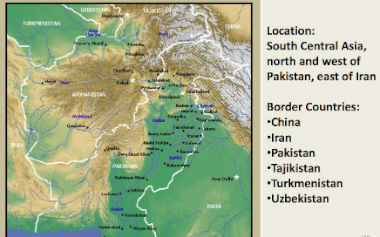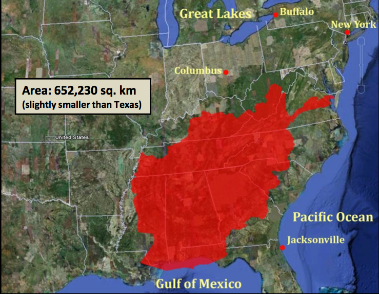
 Social StatisticsPopulation:
Social StatisticsPopulation:
28.396 Million (2009 est.)
0-14 years: 44.5%
(male 7,664,670/female 7,300,446)
15-64 years: 53%
(male 9,147,846/female 8,679,800)
65 years and over: 2.4%
(male 394,572/female 422,603) (2009 est.)
Total Fertility Rate:
6.53 children born/woman
Under-5 Mortality:
(m/f) 232/237 per 1000
Life Expectancy at Birth:
Total population: 44.64 yrs
Male: 44.47 yrs
Female: 44.81 yrs (2009 est.)
Literacy:
Age 15 and over can read and write
total pop.: 28.1%
male: 43.1%
female: 12.6% (2000 est.)
School life expectancy:
total: 8 years male
11 years female
4 years (2004)
Percentage of population using improved drinking-water sources, 2006, total: 20%
GDP per capita: $700 (2008 est.)
Labor force: 15 million (2004 est.)
Unemployment Rate: 40%
Urban Population: 24% of total population
Economy Overview
• Wheat and cereal production along with fruit and nuts have long been Afghanistan's traditional agricultural mainstays
• Afghanistan is extremely poor, landlocked, and very dependent on foreign aid • There is a shortage of housing, clean water, electricity, medical care, and jobs • Other challenges include corruption and a huge illicit opium trade • Agriculture: 80%, Industry: 10%, Services: 10% (2004 est.)
• Afghanistan has a wealth of natural resources to include: natural gas, petroleum, oil, marble, gold, copper, chromate, talc, barites, sulfur, lead, zinc, iron ore, and salt
• Exploration indicates abundant deposits of precious and semi precious gemstones, including emerald, ruby, sapphire, garnet, lapis, kunzite, spinel, tourmaline, and peridot; most mining and exportation of these precious and semi precious gems is illegal
• Illegal and unregulated deforestation has depleted much of the country’s timber industry and has left much of the once forested areas barren
• Afghan hand woven rugs are one of the more popular exports along with leather, furs, and hand crafted replica antiques
• Overall the economy of Afghanistan has improved significantly since 2002 due to the infusion of billions of US dollars and international aid
• Exchange rate: 1 $US = 50 Afghanis (AFs)
• Afghanistan’s economy remains weak as economic production is insufficient to generate sufficient personal incomes, to sustain an effective public sector or to finance its wide-ranging imports of finished goods and services.
• In addition to the continuing problems of security, low employment, poor labor productivity, a lack of capital and poor capital productivity, a lack of a comprehensive set of policies to encourage entrepreneurship make the situation very discouraging.
• The Afghan economy has historically remained mostly agricultural in spite of the fact the country is only 12% arable and less than 6% is cultivated; there is almost no use of modern farming techniques to include: the use of farm equipment, chemical fertilizer, or pesticides; irrigation is primitive and totally dependent on the winter snows and seasonal rainfall; fruit and nuts exports average around $115 million a year but could easily be ten times that amount with a little investment.
• Although security has been a major hindrance to Afghanistan’s economic progress, the ability of the Afghan government to extend its reach throughout the country poses the biggest threat to future economic growth; illicit opium production and trade generates roughly 3 billion dollars a year and remains one of Kabul’s largest policy concerns.
Read the complete post at http://afghanlessons.blogspot.com/2010/05/afghanistan-geography-social-stats-and.html
Posted
May 22 2010, 06:40 AM
by
A.L.L. = Afghan Lessons Learned for Soldiers